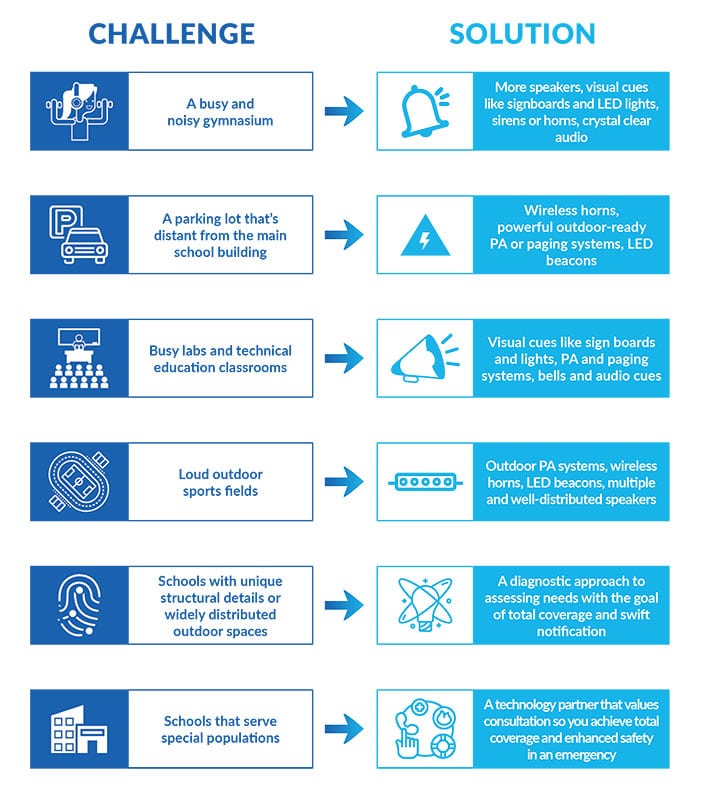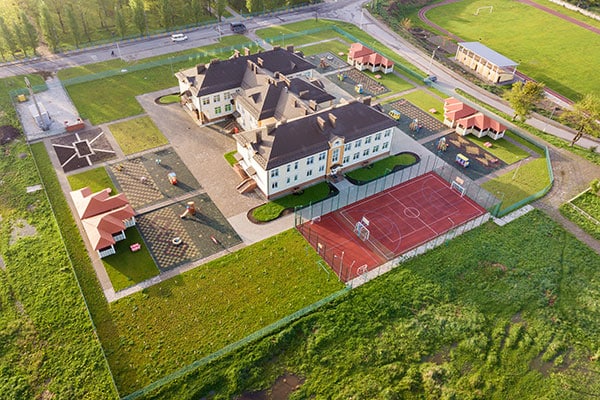Our nation seems to be locked in an unending battle to keep our school communities safe havens for learning and growth, free from violent acts like the active shooter tragedies that have left in their wake unimaginable devastation. Unceasingly, education and law enforcement officials wrestle with what to do to keep their students, faculty, staff, and visitors safe during an emergency. At Eastern DataComm, we have been helping US schools transform their emergency notification with customized, integrated technology solutions for years. And today, we’re sharing one of the most essential components of emergency notification: total emergency communication coverage.
What Does Total Coverage Really Mean and Why Is That Benchmark Too Often Missed?
‘Total coverage’ means that everyone within school buildings and on campus grounds – and we do mean everyone, from students to new substitute teachers to visitors – can swiftly receive and understand emergency notifications. This cornerstone of the school safety ecosystem may seem like an obvious one. However, countless times, during our School Safety Audits, we unearth vulnerabilities that truly take an expert eye to be able to reveal. Though safety is a paramount concern for all school officials, it takes a partner with both the technology savvy and thorough understanding of school operations and facilities to map out and execute the solution implementation that achieves total coverage.
That said, we find at times that schools are unknowingly providing safety solutions that only achieve partial coverage. While it’s clear that such an oversight is not intentional, it may lead to a false sense of security when there are potentially devastating gaps in the emergency notification process.
Missing the total coverage benchmark may look different depending on the school. Perhaps an older paging system is in use that still ‘works’, but doesn’t deliver messages that are clearly audible and able to be understood by all. Alternatively, there may not be enough speakers in loud or outdoor areas, so again, a message can be missed when there are other sound/noise elements at play. Another frequent case we encounter is that some schools will opt to rely on a single mode of notification like a text alert-only system to provide notifications without realizing that single-mode communication has notable downsides.
In each of these cases, there is a greater chance that someone or a group of people may not receive or understand the emergency notification in a way that allows them to respond accordingly when every second counts.
What Total Coverage and True Preparedness Looks Like
Families, school leaders, and district administrators know that unless 100% of those in their buildings and on their grounds are notified in the event of an emergency, they’re not truly prepared to respond fully. Lack of total coverage introduces the possibility for error and puts people in harm’s way.
In light of this knowledge, it’s important to consider what true preparedness through total coverage means for school communities and districts.
The key to achieving total coverage is the ability to use technology solutions like the paging and related systems as comprehensively as possible. Complete coverage, no doubt, includes an indoor and outdoor PA system and accompanying wireless speakers. It will also include visual cues such as LED beacons and signboards in high-volume or noise-polluted areas such as cafeterias, gymnasiums, and music rooms. The goal is to have both auditory and visual cues reach such spaces, even the remote areas like parking lots and sports fields.
This multimodal approach to total coverage ensures that no matter where someone might be on your school campus grounds, they can be easily and near-instantaneously made aware of an emergency situation once the threat is recognized.
Common Challenges to Achieving Total Coverage
While total coverage is an extremely important component of the school safety ecosystem, there are often factors that can impede a school community from achieving it.
The challenges to overcome may include, but are not limited to:
- Loud areas within a building (like cafeterias and gyms)
- Distant outdoor spaces (like remote parking lots and sports fields)
- Areas where students don’t have phone/smart device access (like technical education classrooms, athletic practices, or labs)
- Unique structural design considerations (especially in older buildings) that can impair signal, and ultimately message reception
Additional considerations are at play for schools that serve special needs or other unique populations when emergency notification and communication are concerned. This warrants solutions that are custom-tailored to enable all present on campus to know of an impending threat regardless of ability.
We’ve found that administrators and leaders at these schools understand this critical importance. When it comes to their pursuit of total coverage, it’s of top priority that they do all they can to understand potential shortcomings in their emergency notification approach. Through careful examination of facilities and daily operations, it becomes possible to ensure that these students are able to receive and act upon emergency notifications.
This is especially true when a school has a unique population. When working with St. Joseph’s School for the Blind, for example, Eastern DataComm collaborated with school officials to design a solution and develop a project plan that recognized the needs of the students with special needs, specifically visual impairments. The system featured multimodal approaches to notification that went beyond typical text or audio notification. This resulted in a custom-tailored solution that keeps all persons on campus connected and protected.
Total Coverage Is Unique to You
Just as schools that serve special populations must address some unique facets of total coverage, it’s important to understand that your school or district’s total coverage solution will look different than another school or district’s approach. Through serving hundreds of schools over the years, our team has learned that it is the absolute truth: No two schools are exactly alike. Your needs and vulnerabilities will inform how you set your school up for success and how you address your school’s challenges to achieve total notification coverage.
At Eastern DataComm, we understand comprehensive system design and work with your building and facility managers to best serve your school’s structural blueprint in unison with your existing technology footprint. We strive for a seamless integration that allows for all systems, across facilities, to work together to provide the best in total coverage.
For instance, some areas incur more noise pollution than others. We adapt our approach to ensure there is no disruption of emergency notification messaging, regardless of competing sounds. The result is not simply the placement across the entirety of your school grounds, but the use of additional speakers, or visual cues like signboards and LED beacons where you need them most (from technical education classrooms and gyms to fields and parking lots).

Total Coverage Means Taking Sound Quality and Audibility Seriously
Another important aspect of total coverage involves working with a technology partner that understands the vital part audibility and sound quality play when it comes to emergency notification.
Just as you wouldn’t rely on a single mode of notification, you don’t want to rely on a mode of communication that’s hard to hear or comprehend.
At Eastern DataComm, our consultative and diagnostic process involves an in-depth approach to evaluating your needs. We don’t rely on any ‘guess and check’ approaches to technology solution implementation because our methodology is practical, not just theoretical. Our assessment uses tactics to get a true sense of your school campus’s needs, strengths, and potential vulnerabilities. We use that information to inform the recommendations we make regarding how you and your school community can achieve total coverage.
And because we’ve been working for years with hundreds of schools of various sizes and populations, you can feel confident that you’ve chosen the right technology partner. No matter the scale of what comprises your buildings and grounds, we have the prior project experience and practical knowledge to give you the best-in-class safety and communications solutions.
Understanding, for example, how elements like carpet, hardwood, cement walls, student activity, and indoor or outdoor space can impact the acoustics of a space or otherwise impact the ability for notification to be received and understood – that expertise separates us from others in the field who provide one-size-fits-all solutions that leave vulnerabilities on the table and potential for catastrophe to creep in to a school’s safety ecosystem. When you work with Eastern DataComm, the result is total coverage when you need it most.
Bring Total Coverage to Your School Community with Eastern DataComm
For a comprehensive approach to keeping your community safe through total emergency notifications coverage, contact Eastern DataComm for a complimentary School Safety Consultation.


